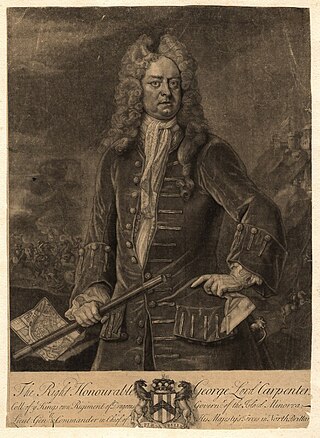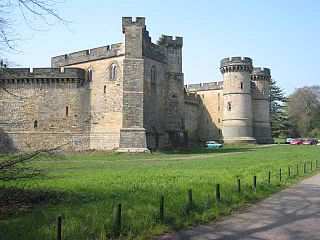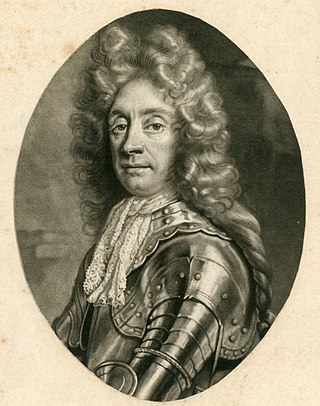Related Research Articles

Patrick Sarsfield, 1st Earl of Lucan was an Irish soldier and leading figure in the Jacobite army during the 1689 to 1691 Williamite War in Ireland.

The Williamite War in Ireland took place from March 1689 to October 1691. Fought between supporters of James II and his successor, William III, it resulted in a Williamite victory. It is generally viewed as a related conflict of the 1688 to 1697 Nine Years' War.

Godard van Reede, 1st Earl of Athlone, Baron van Reede, Lord of Ginkel, born in the Netherlands as Baron Godard van Reede, was a Dutch general who rose to prominence during the Williamite War in Ireland.

A Williamite was a follower of King William III of England who deposed King James II and VII in the Glorious Revolution. William, the Stadtholder of the Dutch Republic, replaced James with the support of English Whigs.

Henry Luttrell was an Irish soldier known for his service in the Jacobite cause. A career soldier, Luttrell served James II in England until his overthrow in 1688. In Ireland he continued to fight for James, reaching the rank of General in the Irish Army.

Major General Charles Trelawny, also spelt 'Trelawney', was an English soldier from Cornwall who played a prominent part in the 1688 Glorious Revolution, and was a Member of Parliament for various seats between 1685 and 1713.

Lieutenant-General George Carpenter, 1st Baron Carpenter was a British Army officer, Whig politician and peer. He served as Commander-in-Chief, Scotland from 1716 to 1724 and as a member of parliament from 1715 to 1727.

Sir Bevil Granville MP JP was an English soldier and politician from Cornwall, who was MP for Fowey and Lostwithiel from 1690 to 1698. He also served as Governor of Pendennis Castle from 1693 to 1703 and Governor of Barbados from 1703 to 1706, and died at sea on his return voyage to England in September 1706.

Sir Henry Belasyse, also spelt Bellasis, was an English military officer from County Durham, who also sat as MP for a number of constituencies between 1695 and 1715.

Lieutenant-General George Ramsay was a younger son of the Earl of Dalhousie and Scottish professional soldier.

The Irish Army or Irish establishment, in practice called the monarch's "army in Ireland" or "army of Ireland", was the standing army of the Kingdom of Ireland, a client state of England and subsequently of Great Britain. It existed from the early 1660s until merged into the British Army in 1801, and for much of the period was the largest force available to the British monarchy, being substantially larger than the English and Scottish establishments.
Lawrence Dempsey was an Irish soldier of the seventeenth century.
Robert Ramsay was a Scottish Jacobite soldier noted for his service during the Williamite War in Ireland. A Roman Catholic and veteran of the "French Brigade" which served in the Third Anglo-Dutch War under the Duke of Monmouth, Ramsay held the post of Adjutant-General of Foot in the English Army prior to the deposition of James II in the 1688 Glorious Revolution.
Henry Wharton was an English soldier known for his service in the Williamite War in Ireland, where he died in 1689. He was a distant relation of his namesake the writer Henry Wharton.
John Cunningham was an Anglo-Irish soldier known for his command of an aborted attempt to relieve the city of Derry during the 1689 Siege. His failure led to his dismissal and replacement by William Stewart. Some sources refer to him as Thomas Cunningham, but the vast majority called him John.
Sir Charles Carney was an Irish professional soldier, who later in his career became a Jacobite. He served as an officer in the Irish Army of James II during the Williamite War in Ireland.

Philip Babington (1632–1690) was an English military officer, who served in the armies of the Commonwealth of England, the Dutch Republic and England. He accompanied William III to England in the 1688 Glorious Revolution and was Member of Parliament and Governor for Berwick-upon-Tweed from 1689 to 1690.

William Dorrington was an English army officer. Contemporary sources often spell his surname as "Dorington", or "Dodington".
Dominic Sheldon, often written as Dominick Sheldon, was an English soldier. A leading Jacobite he served in James II's Irish Army during the Williamite War between 1689 and 1691. He was a noted cavalry commander, present at the Battle of the Boyne and Battle of Aughrim. Later after going into exile, he rose to the rank of lieutenant general in the French Army. He was also remained a prominent courtier at the Jacobite court in exile at Saint Germain.

Thomas Maxwell was a Scottish professional soldier.